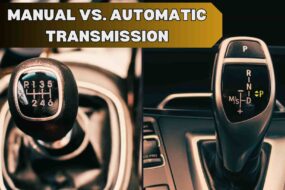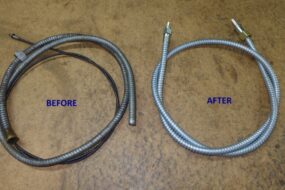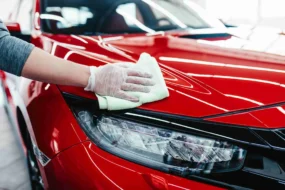The dash from the Rover CCV (Coupe Concept Vehicle) shows how clear electronic dashboard instruments can be.
Much of the information that a modern dashboard can give the driver has been made possible by the electronics revolution over the past ten years or so.
Electronics has also influenced dashboard displays.
Many cars now have digital speedometers that display their information either as a changing figure or as a diagram, showing the engine speed climbing up a graph as it rises. Once you are used to this sort of display, it is very easy to register the figure for the car’s speed, instead of having to note the
position of a needle on a dial as on the old speedometer.
Electronic dashes are already in use today on some cars. The Aston Martin Lagonda features an electronic dash.
Supplementary instruments have changed too. Gone are the pointer needles and
in place are bar graphs giving information readout.
Another likely future development is radio-based information systems. One of these, already under review in Germany, consists of transmitters
which give information about road conditions.
At the moment, the system works only when the radio is on —the transmitters override the programme to give information. But, with a suitable radio, a signal from the transmitter could automatically turn the
radio on to warn the driver about impending difficulties.
On-board maps
Philips are currently developing a system that allows you to store maps
on compact video disc.
The system consists of a compact video disc player and a TV screen. The disc with the appropriate maps for that country are loaded in. The driver can then select an area and see exactly where he is and where to go. The
system keeps a track of where the driver is on the map.
Early attempts at the electronic dash were regarded as a gimmick more than anything else. These instrument packs usually employed LED (light-emitting diode) displays, which were difficult to read if caught by bright sunlight, and
were generally of rather poor quality.
Research developed the newer vacuum-fluorescent displays, which give a much clearer readout. These are used in many new cars, such as the latest
Jaguars.
But LED displays are making a comeback. The electronic dash in the latest Vauxhall Astra uses a new way of driving the LED display to make it work better than the old LEDs. Renault, on the other hand, have chosen to use an LCD
(liquid-crystal display) in their 21.
Computer control
One of the advantages that all these dashes have is that they can be readily linked into an on-board car computer and cruise-control. This means that all the information required can be displayed on the one panel, rather than having
it scattered around the dash.
Since having all the information possible on the screen would make the display difficult to read, only the most important information will remain on the screen all the time. Extra data will be called up and displayed when
necessary.
With high-tech electronic dashboards, the trend is towards having an electronic check system – with fewer separate instruments. The check system constantly monitors important functions and gives the driver a warning if any
of them is about to fail.
Rather than just displaying a warning light, a check system can distinguish between different degrees of danger in the malfunctions they detect, and react
accordingly. Audi use a such a system on many of their latest models.
Future trends
It is likely that the appearance of instruments in the future will be influenced by fashion as much as by function. The real change will probably be
in the reduction in the number of wires which feed them.
One system which has been suggested for cars is the head-up display as used in aircraft. This type of display projects information on to the
windscreen.







